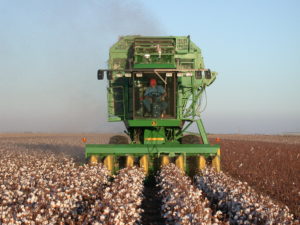 Many aspects of cotton production involve engineering. Various machines are used for tillage and soil preparation, fertilization, planting, weeding, spraying, irrigation, and harvesting. Modern systems are also beginning to include many sensors, communication systems, data analysis and even artificial intelligence. Therefore, Cotton Engineering is critical to the process of cotton production.
Many aspects of cotton production involve engineering. Various machines are used for tillage and soil preparation, fertilization, planting, weeding, spraying, irrigation, and harvesting. Modern systems are also beginning to include many sensors, communication systems, data analysis and even artificial intelligence. Therefore, Cotton Engineering is critical to the process of cotton production.
Projects:
-
Field-based Detection and Removal of Plastic Contamination of Cotton
Any non-cotton material in a bale of cotton fiber is undesirable, and some contaminants like plastics can cause major problems when spun into yarn along with cotton fiber. One point at which plastic contaminants can enter cotton is during harvest, when various types of plastic like shopping bags may be present in a farm field, and pieces are inadvertently ingested into the harvester along with the seed cotton. Therefore, the Cotton Engineering program has been conducting research to determine whether plastic shopping bags that may blow into a cotton field can be detected and potentially removed by a UAV flying over the field with a camera.
-
Enhancing Accuracy and Reliability of Image Data from UAV Remote Sensing
Images that are captured with UAVs can potentially be used to make decisions about when and where to apply irrigation water, defoliant, pesticide, etc. It is critical that these images contain information that is consistently accurate and trustworthy. The Cotton Engineering program has been conducting research on methods to calibrate UAV image data, and the accuracy of the data has been vastly improved with the methods developed in this project. The methods involve not only UAVs but also ground-based robots that position themselves under the UAV during image collection serve as references for calibrating the data.
-
Detection, Identification, and Mitigation of Volunteer Cotton Plants
Volunteer or “feral” cotton plants are those that were not planted as part of a crop in normal farm operations. These plants can result from seeds left (1) in the field from a prior growing season, in which case cotton plants may grow up in a corn field, for example; (2) in areas where seed cotton modules were stored; and (3) along roadsides where modules are transported from the field to the gin and seed cotton blows off the truck. These plants can present a growth habitat for destructive insects like the cotton boll weevil, so it is important to either destroy them or treat them. The Cotton Engineering program has been conducting research to determine whether feral cotton plants can be detected by a UAV flying over the field or roadside with a camera.
-
High-Moisture Seed Cotton Issues in Harvesting, Transport, Storage, and Ginning
In some areas of the Cotton Belt, high levels of moisture in harvested seed cotton can present problems. High moisture can be caused by harvesting when the cotton is damp due to condensation (dew) or precipitation, or it can be cause by storing the cotton in areas where water pools. A good deal of moisture can be removed from seed cotton during ginning by applying warm air from dryers. However, cotton that is excessively wet, particularly if the seeds are wet and have become soft, can be very difficult to gin, thus drastically slowing ginning and increasing the per-bale ginning cost. The Cotton Engineering program is conducting research on the origins and effects of high-moisture seed cotton in order to minimize the problem.
-
Robotic Harvesting
Cotton harvesting in the U.S. is done with very large and expensive machines. These machines are highly efficient, but their use requires once-over harvesting that does not allow for optimization of the quality of the cotton. Cotton bolls start opening up early in the season, exposing the fiber to weathering and quality degradation for many weeks until the final harvest. Periodic harvesting would enable cotton bolls to be harvested soon after opening, maximizing the quality of the fiber. Furthermore, the large harvesting machines are very heavy and have the potential to cause problems with soil compaction in the field. For these and other reasons the use of small robotic harvesting machines that could harvest open cotton bolls multiple times in a growing season has potential advantages. The Cotton Engineering program has been conducting research on robot “end-effectors” that would enable a small robot to pick seed cotton from an open boll without any human involvement.
-
Tracking Round Modules and Wrap Damage with RFID
The rapid adoption of the round module system in the cotton industry provides new opportunities for improved logistics, but has created a major potential source of contamination. While a number of studies have modeled transportation costs of round modules from the field to gin, the costs of staging modules in the field and handling on the gin yard are not known. The Cotton Engineering Program is conducting research on tracking the movement of round modules, which will allow labor and equipment costs for handling to be estimated. Evidence indicates that well-formed modules with intact wrap are not the source of most contamination, so we are capturing images of modules during handling to determine when wrap damage occurs and leads to contamination.